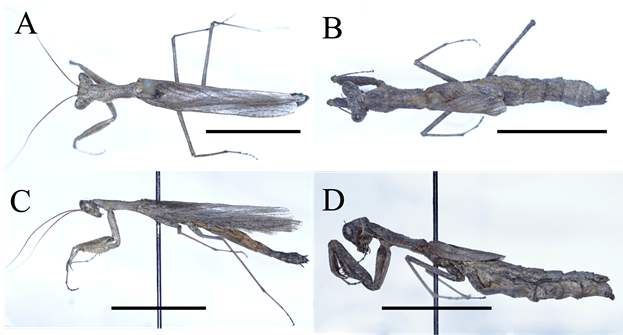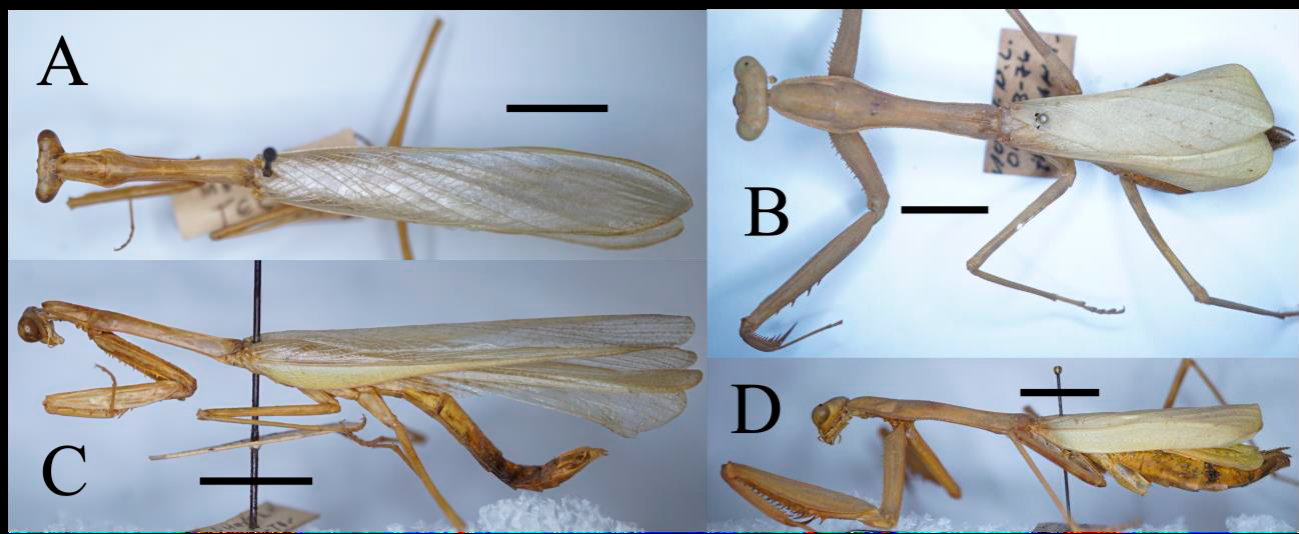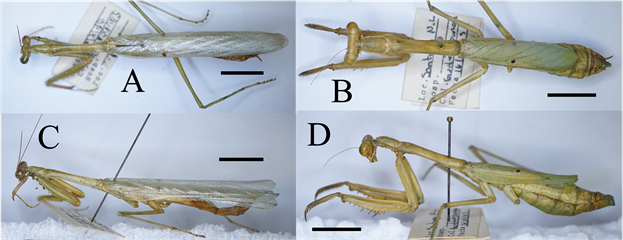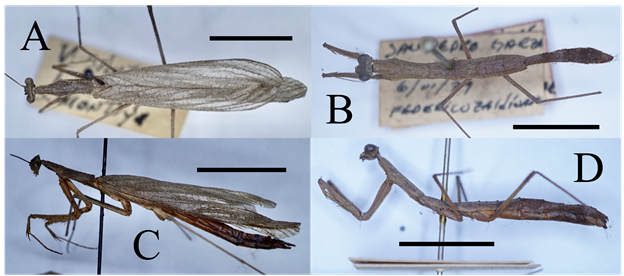Introduction
Mantodea is a rather small order of insects, consisting of around 2500 species (Wieland & Svenson, 2018); the members of this order are commonly referred to as mantises or campamochas (one of the most popular names used in Mexico for the order), and are characterized by their raptorial forelegs, and by the way females lay a group of eggs inside a protective cover called ootheca. They are most closely related to the cockroaches and termites of the order Blattodea, the two orders belonging to a clade called Dictyoptera (Roy, 1999; Wieland & Svenson, 2018). Despite being one of the most “charismatic” groups among the insects (Greyvenstein et al., 2020), there are relatively few works regarding their diversity and distribution in Mexico (Álvarez et al., 2017; Battiston et al., 2005; de Luna & Hernández-Baltazar, 2020; Hernández-Baltazar & Gómez, 2017; Hernández-Baltazar et al., 2018a; 2018b; 2019; Núñez-Vázquez et al., 2006; Ramos-Patlán et al., 2018; Reyes-Ibarra, 2020; Vásquez-Quintero, 2017; Vásquez-Quintero et al., 2016).
The state of Nuevo Leon, in northeastern Mexico, first had its mantid fauna analyzed by Reyes-Ibarra (2020), who mentioned 11 species for the state. These records were obtained by examining the specimens deposited in the Entomological Collection of the Facultad de Ciencias Biológicas (FCB) of the Universidad Autónoma de Nuevo León (UANL); however, there were two issues with this publication, as it did not cite the material examined in any way and did not provide any images that would allow confirmation on the identification of the specimens. Biological collections store specimens in conditions that should guarantee their integrity over time, their main objective being to provide information at different levels: historical, geographical, genetical, ecological, anatomical, and morphological (Trujillo et al., 2014). For Mantodea, as well as with other orders of arthropods which are not as well represented in biological collections, the lack of specimens creates a problem, as they are needed to compare and properly identify species, as well as correlate sexes (Salazar & Stiewe, 2008).
The main goal of this publication is to re-examine the material in the Entomological Collection of the FCB-UANL and provide a full list of specimens, as well as photographs which would allow the species to be properly determined. These records were complemented with specimens deposited in the Laboratorio de Entomología of the Facultad de Ciencias Forestales (FCF) of the same university.
Materials and methods
The specimens examined are deposited in two collections, the Entomological Collection of the FCB-UANL (33 specimens, most dry-pinned, some in ethanol), and the Laboratorio de Entomología of the FCF-UANL (17 specimens, all in ethanol). The samples were analyzed with the help of two stereomicroscopes, an AmScope SM-1TSZ and a Leica EZ4 W. The photographs shown were taken with the help of a SONY α-6000 with an adapted SEL30M35 macro lens, as well as with the Leica EZ4 W stereomicroscope integrated camera; all the images were edited using the software GIMP© version 2.10 (The GIMP Development Team, 2019).
To identify the family and genus of each specimen, the keys present in the works of Anderson (2019), de Luna and Hernández-Baltazar (2020), and Terra (1995), were employed. Finally, the species were determined using keys as well as original and subsequent descriptions of the taxa (Anderson, 2018; 2019; 2020a; 2020b; 2021; 2022a; 2022b; Rivera & Svenson, 2020; Saussure, 1871; 1872a; 1872b; Saussure & Zehntner, 1894). The checklist is arranged alphabetically and follows Schwarz and Roy (2019). An identification key for the species registered for the state was prepared using the aforementioned keys and descriptions; species with potential distribution in Nuevo Leon were included in this key.
Results and discussion
I. CHECKLIST OF MANTISES (INSECTA: MANTODEA) OF NUEVO LEON, MEXICO
Order MANTODEA Burmeister, 1838
Family I. AMELIDAE Giglio-Tos, 1919
Genus i. Litaneutria Saussure, 1892
1. Litaneutria minor (Scudder, 1872)

Figure 1 Litaneutria minor (Amelidae); scale bars = 1 cm. A) ♂︎, dorsal aspect. B) ♀︎, dorsal aspect. C) ♂︎, lateral aspect. D) ♀︎, lateral aspect.
Material examined. MEXICO. Nuevo Leon: Parque Ecológico “La Estanzuela”, Monterrey, 24 September 1996, col. Liliana V., among bushes, 1♀︎ (FCB-UANL-17-06-022); Santiago, 1 October 1973, col. R. Aguirre C., 1♀︎ (FCB-UANL-17-06-023); El Cerrito, Santiago, 16 June 1979, col. Mario Díaz L., 1♀︎ (FCB-UANL-17-06-024); Apodaca, 19 September 1967, 1♂︎ (FCB-UANL-17-06-025); Apodaca, 15 April 1974, col. A. Rodríguez, 1♂︎ (FCB-UANL-17-06-026); Campo experimental, Apodaca, 30 November 1982, col. Antonio Muñoz, 1♂︎ (FCB-UANL-17-06-027); Monterrey, 10 October 1966, col. Rubén D. Rodríguez, 1♂︎ (FCB-UANL-17-06-028); Cascadas Cola de Caballo, 19 October 1979, col. Arali Mtz., 1♂︎ (FCB-UANL-17-06-029); Colonia del Valle, San Pedro Garza García, 3 October 1967, col. R. Esquer, 1♂︎ (FCB-UANL-17-06-030); Escobedo, 18 January 2020, col. Axel Pedraza, trunk of a tree, 2♀︎♀︎ (FCB-UANL-17-06-031, 032); Sierra de la Ventana, Santa Catarina, 28 December 2019, col. Roberto Garcia-Barrios, 1♀︎ (FCF-MANTO029); Nacataz, García, 7 November 2020, col. Roberto García-Barrios, 1♀︎ (FCF-MANTO057).
Identified to species level with the keys and descriptions present in the works of Anderson (2018; 2019; 2021).
Genus ii. YersiniaSaussure, 1869
2. Yersinia mexicana (Saussure, 1859)
No specimens were available for examination.
Battiston et al. (2005) reported one male from Santiago de Los Lirios in Cascadas Cola de Caballo in the municipality of Santiago.
Notes on Amelidae from Nuevo Leon. Litaneutria ocularis Saussure, 1892 was mentioned for the state by Hernández-Baltazar and Gómez (2017), de Luna and Hernández-Baltazar (2020), and Reyes-Ibarra (2020), all from literature records. In his latest revision of the genus, Anderson (2021) restricted L. ocularis for northwestern Mexico, including the Baja California peninsula, as well as extreme southwestern USA. Considering all the specimens examined corresponded to L. minor, as well as the comments from Anderson (2021), we hereby recommend the exclusion of L. ocularis from the Nuevo Leon mantid fauna until proven otherwise, proposing previous records as misidentifications of specimens of L. minor.
The first mention of Litaneutria emarginataAnderson, 2018 for Nuevo Leon is given by Reyes-Ibarra (2020); however, no physical specimen remained in the FCB-UANL collection that could confirm its presence; therefore, we also recommend the exclusion of this species from the state and national mantid fauna until a specimen is properly collected and identified.
Family II. MANTIDAE Burmeister, 1838
Genus iii. PseudovatesSaussure, 1869
3. Pseudovates chlorophaea (Blanchard, 1836)

Figure 2 Pseudovates chlorophaea (Mantidae); scale bars = 1 cm. A) ♂︎, dorsal aspect. B) ♀︎, dorsal aspect. C) ♂︎, lateral aspect. D) ♀︎, lateral aspect.
Material examined. MEXICO. Nuevo Leon: without specific locality, 19 May 1977, col. José Davila, 1♂︎ (FCB-UANL-17-22-011); Río la Silla, Guadalupe, 23 November 2019, col. Sofia Liñan, 1♂︎ (FCB-UANL-17-22-010); Colonia Sierra Madre, San Pedro Garza García, 31 October 1972, col. J. A. Gamboz, 1♀︎ (FCB-UANL-17-22-008); Bd. Torrel, Monterrey, 29 September 1974, col. Alejandra Garza, 1♀︎ (FCB-UANL-17-22-007); Parque Natural “La Estanzuela”, 15 November 2018, col. Arturo Alan Palacios, 1♀︎ (FCF-MANTO002); Parque Natural “La Estanzuela”, 15 July 2017, col. Brisia Torres Arredondo, 1♀︎ (FCF-MANTO003); Mamulique, Salinas Victoria, 30 September 2019, col. David Ortega, 1♂︎ (FCF-MANTO022); Allende, 31 January 2015, col. Francisco Miguel Puente Guevara, 1♂︎ (FCF-MANTO049).
Identified to species level with the keys and descriptions present in the works of Anderson (2018; 2019) and Saussure and Zehntner (1894).
Genus iv. StagmomantisSaussure, 1869
4. Stagmomantis (Auromantis) limbata (Hahn, 1835)

Figure 3 Stagmomantis (Auromantis) limbata (Mantidae), green morph; scale bars = 1cm. A) ♂︎, dorsal aspect. B) ♀︎, dorsal aspect. C) ♂︎, lateral aspect. D) ♀︎, lateral aspect.
Material examined. MEXICO. Nuevo Leon: Cascadas Cola de Caballo, Santiago, 6 October 1979, col. B. Palies, 1♀︎ (FCB-UANL-17-22-015); Cascadas Cola de Caballo, Santiago, 23 March 1977, col. Aguilar, 1♂︎ (FCB-UANL-17-22-014); Monterrey, 3 October 1976, col. Hernán M., 1♀︎ (FCB-UANL-17-013); Tecnológico de Monterrey, Monterrey, no date, col. E. Chávez K., 1♂︎ (FCB-17-22-012); Cerro de las Mitras, 15 April 2020, col. Roberto García-Barrios, 1♂︎ (FCF-MANTO155).
Identified to species level with the keys and descriptions present in the works of Anderson (2018; 2019; 2020a).
5. Stagmomantis (Stagmomantis) conspurcata (Audinet-Serville, 1839)

Figure 4 Stagmomantis (Stagmomantis) conspurcata (Mantidae), green morph; scale bars = 1 cm. A) ♂︎, dorsal aspect. B) ♀︎, dorsal aspect. C) ♂︎, lateral aspect. D) ♀︎, lateral aspect.

Figure 5 Stagmomantis (Stagmomantis) conspurcata (Mantidae), brown morph; scale bars = 1 cm. A) ♂︎, dorsal aspect. B) ♀︎, dorsal aspect. C) ♂︎, lateral aspect. D) ♀︎, lateral aspect.
Material examined. MEXICO. Nuevo Leon: Río la Silla, Guadalupe, 25 October 2019, col. Ventura Salas, 1♂︎ (FCB-UANL-17-22-016); Monterrey, 6 October 1990, col. E. Vázquez, 1♂︎ (FCB-UANL-17-22-017); Parque Ecológico “Chipinque”, San Pedro Garza García, 7 October 1990, col. G. Albo, 1♂︎ (FCB-UANL-17-22-018); Santiago, 16 October 1995, col. Guillermo Pinal, 1♀︎ (FCB-UANL-17-22-019); Parque Ecológico “La Estanzuela”, Monterrey, 12 November 2019, 2♀︎♀︎ (FCB-UANL-17-22-020, 021); Cascadas del Cerro de la Silla, Guadalupe, 2 November 2018, col. Lizbeth Saavedra, riparian vegetation, 1♀︎ (FCB-UANL-17-06-007); Escobedo, 18 January 2020, col. Axel Pedraza, trunk of a tree, 1♂︎ (FCB-UANL-17-06-008); Cascadas del Cerro de la Silla, Guadalupe, 17 November 2018, col. Beatriz García, 1♂︎3♀︎♀︎ (FCF-MANTO004-007); Sierra de la Ventana, Santa Catarina, 15 November 2019, col. Roberto García-Barrios, 2♀︎♀︎ (FCF-MANTO076, 077); Cerro de la Silla, 15 November 2018, col. Raúl Zamarripa, 3♀︎♀︎ (FCF-MANTO078, 079, 087); Cerro de la Silla, 13 October 2018, col. Raúl Zamarripa, 1♂︎1♀︎ (FCF-MANTO080, 081); Cerro de las Mitras, 15 April 2020, col. Roberto García-Barrios, 1♀︎ (FCF-MANTO154).
Identified to species level with the keys and descriptions present in the works of Anderson (2018; 2019; 2020a; 2020b).
Notes on Mantidae from Nuevo Leon. Mexican records of Stagmomantis (Stagmomantis) carolina (Johansson, 1763), including its mention in the work of Reyes-Ibarra (2020, as Stagmomantis carolina (Linné, 1763)), should belong to S. (S.) conspurcata (Anderson, 2020b; de Luna & Hernández-Baltazar, 2020); therefore, we hereby exclude S. (S.) carolina for the Nuevo Leon mantid fauna.
FAMILY III. THESPIDAE Giglio-Tos, 1919
Genus v. BistantaAnderson, 2018
6. Bistanta campestris Anderson, 2022

Figure 6 Bistanta campestris (Thespidae); scale bars = 1 cm. A) ♂︎, dorsal aspect. B) ♂︎, lateral aspect.
Material examined. MEXICO. Nuevo Leon: Apodaca, 20 February 2016, col. Blanca A. Ortiz Rodriguez, 1♂︎ (FCF-MANTO031); campus of the Facultad de Ciencias Forestales, Linares, 15 November 2021, col. Manuel de Luna, 1 ♂︎ (FCF-MANTO012).
Identified to species level with the keys and descriptions present in the work of Anderson (2022a).
Genus vi. OligonyxSaussure, 1869
7. Oligonyx bicornis Saussure, 1869

Figure 7 Oligonyx bicornis (Thespidae). A) ♀︎, dorsal aspect; scale bar = 1 cm. B) ♀︎, frontal aspect of head; scale bar = 1 mm.
Material examined. MEXICO. Nuevo Leon: Monterrey, 14 June 1977, col. M. R. Sandoval, 1♀︎ (FCB-UANL-17-06-005).
Identified to species level with the keys and descriptions present in the works of Saussure (1869; 1871; 1872b) and Saussure and Zehntner (1894).
Genus vii. Thespis Serville, 1831
8. Thespis parva (Gmelin, 1790)

Figure 8 Thespis parva (Thespidae); scale bars = 1 cm. A) ♂︎, dorsal aspect. B) ♀︎, dorsal aspect. C) ♂︎, lateral aspect. D) ♀︎, lateral aspect.
Material examined. MEXICO. Nuevo Leon: Cascadas del Cerro de la Silla, Guadalupe, 2 November 2018, col. Lizbeth Saavedra, riparian vegetation, 1♂︎, 1♀︎ (FCB-UANL-17-06-007); Parque Ecológico “La Estanzuela”, 24 September 1996, col. Fernando Rojas, among bushes, 1♀︎ (FCB-UANL-17-06-006); Villa Montaña, San Pedro Garza García, 6 November 1990, col. M. Cortez, 1♂︎ (FCB-UANL-17-06-003); Santiago, 1 May 1977, col. S. Montoya, 1♂︎ (FCB-UANL-17-06-002); San Pedro Garza García, 6 June 1979, col. Federico Saldivar, 1♀︎ (FCB-UANL-17-06-001); Río Santa Catarina (near “Pabellón M”), Monterrey, 11 January 2019, col. Beatriz Galván, 1♂︎ (FCF-MANTO017); Santiago, 20 February 2020, col. Roberto Garcia-Barrios, 2♀︎♀︎ (FCF-MANTO058, 059).
Identified to species level with the keys and descriptions present in the works of Anderson (2018, 2019, 2022b), Saussure (1870), and Rivera & Svenson (2020). Battiston et al. (2005) reported one male (as Oligonicella bolliana Saussure & Zehntner, 1894) from rd. 40 to Santa Catarina in the municipality of Monterrey.
Notes on Thespidae from Nuevo Leon. Oligonicella bolliana, reported by Battiston et al. (2005) and mentioned by Reyes-Ibarra (2020), and Oligonicella scudderi, mentioned by de Luna and Hernández-Baltazar (2020), are junior synonyms of Thespis parva (Anderson, 2022b).
The record of O. bicornis is the first for the state of Nuevo Leon, as well as the northernmost record for the species and genus (Hernández-Baltazar & Gómez, 2017; de Luna & Hernández-Baltazar, 2020; Rivera & Svenson, 2020).
Jantsch (1999 mentioned Pseudomusonia lineativentris Stål, 1877 for “México: Linares”, referring to the municipality of Linares in the state of Nuevo Leon; this is most likely a labelling error: P. lineativentris is mentioned for Panama and Colombia by Rivera and Svenson (2020), making Jantsch’s (1999) record for Nuevo Leon, in northeastern Mexico, extremely out of place. This was overlooked by both de Luna and Hernández-Baltazar (2020) and Reyes-Ibarra (2020); therefore, we hereby recommend the exclusion of P. lineativentris, and the genus Pseudomusonia Werner, 1909, from both the Nuevo Leon and the Mexican mantid fauna, until otherwise proven.
Other notes. According to Reyes-Ibarra (2020), there were 202 pinned specimens of Mantodea in the Entomological Collection of the FCB-UANL, these did not have the conditions specified by Trujillo et al. (2014). During the current COVID-19 pandemic this collection was left unprotected, and thus, was overrun by pests (dermestid beetles and rodents), which consequently destroyed most of the specimens in the following two years. The remaining pinned specimens are 34 adults with data attached to them: 33 of various species from Nuevo Leon (cited above), and one male Bistanta mexicana (Saussure & Zehntner, 1894) from Rosario, Sinaloa (12 April 1977, col. Juan Amorales, FCF-UANL-17-06-004); the collection also holds eight juvenile specimens (not examined) as well as six adult specimens without clear locality data, or without locality data at all (examined, but not included in the present article). This only shows the importance of properly protecting and caring for scientific collections, and the dire consequences of not doing so.
II. IDENTIFICATION KEY TO THE MANTISES (INSECTA: MANTODEA) OF NUEVO LEON, MEXICO
The following identification key is useful for determining adult specimens of species of mantises (Mantodea) which are present, or are likely present (*), in the state of Nuevo Leon, Mexico. It is based in the keys and descriptions of Anderson (2018; 2019; 2020a; 2020b; 2021; 2022a, 2022b), de Luna & Hernández-Baltazar (2020), Rivera & Svenson (2020), Saussure (1871; 1872a; 1872b), Saussure & Zehntner (1894), and Terra (1995).
1. Anterior femora with five or more posteroventral spines............................................................................ 2
-. Anterior femora with four or less posteroventral spines............................................................................... 4
2. Compound eyes with a pointy apical projection.......................................................... Yersinia mexicana
-. Compound eyes without said projection (Fig. 1A-D)...................................................................................... 3
3. Females (♀︎♀︎) with vertex placed lower than dorsal surface of compound eyes, bearing deep sulcus in middle; males (♂︎♂︎) with compound eyes apically conical.................................................................................................................. Litaneutria emarginata*
-. Females (♀︎♀︎) with vertex slightly raised above dorsal surface of compound eyes, with middle portion smoothed into a shallow arch divided by three furrows; males (♂︎♂︎) with compound eyes apically rounded (Fig. 1A, 1C)........................................................................... Litaneutria minor
4. Anterior tibiae without dorsal spines; juxtaocular protuberances inconspicuous.............................. 5
-. Anterior tibiae with at least one dorsal spine (Fig. 7C); juxtaocular protuberances very notorious (Fig. 8B).................................................................................................................................................................. 7
5. With two cephalic horn-like projections (Fig. 2A-D).................................... Pseudovates chlorophaea
-. Without cephalic projections.................................................................................................................................... 6
6. Females (♀︎♀︎) with broad anterior wings that reach abdominal terguites VI-VII (Fig. 3B, 3D), stigma of posterior wings squared and generally light in color; males (♂︎♂︎) with costal area of anterior wings opaque (Fig. 3A, 3C)................................ Stagmomantis (Auromantis) limbata
-. Females (♀︎♀︎) with narrow forewings that reach abdominal terguites V-VI (Figs. 4A, 4D, 5B, 5D), stigma of posterior wings rounded and dark in color; males (♂︎♂︎) with coastal area of anterior wings hyaline (Figs. 4A, 4C, 5A, 5C)…………………………………………………………………………..
………………………………………………………..………… Stagmomantis (Stagmomantis) conspurcata
7. Pronotum short, with a metazona that is only slightly larger than the prozona (Fig. 8A-D)................................................................................................................................................... Thespis parva
-. Pronotum large, with a metazona that is at least twice as long as the prozona (Figs. 6A-B, 7A)........................................................................................................................................................................... 8
8. Anterior femora with three discoidal spines.................................................................... Oligonyx bicornis
-. Anterior femora with four discoidal spines.................................................................. Bistanta campestris
Conclusions
The order Mantodea is represented in the Mexican state of Nuevo Leon by three families (Amelidae, Mantidae, and Thespidae), seven genera (Litaneutria, Yersinia, Pseudovates, Stagmomantis, Bistanta, Oligonyx and Thespis), and eight species (L. minor, Y. mexicana, P. chlorophaea, S. (A.) limbata, S. (S.) conspurcata, B. campestris, O. bicornis and T. parva).
The current research lowers the number of species in the state to eight, by excluding some and updating the names of others according to current taxonomy: previous mentions of L. ocularis from Nuevo Leon should correspond to L. minor; previous mentions of Oligonicella bolliana and Oligonicella scudderi from Nuevo Leon correspond to T. parva; previous mentions of S. (S.) carolina from Nuevo Leon correspond to S. (S.) conspurcata. While the records of L. emarginata (Reyes-Ibarra, 2020) are likely, they are regarded here as unconfirmed, as we were unable to examine any specimens and there are no previous records in the literature. Oligonyx bicornis is added to the Nuevo Leon mantid fauna. And finally, the literature record of P. lineativentris (Jantsch, 1999) is regarded as dubious.











 nova página do texto(beta)
nova página do texto(beta)



